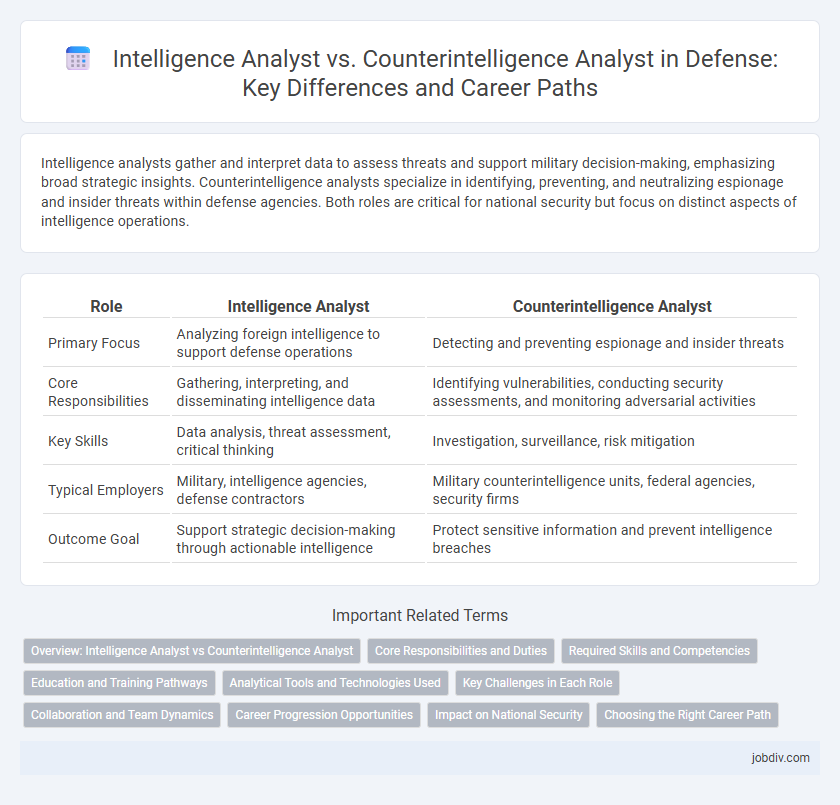Intelligence analysts gather and interpret data to assess threats and support military decision-making, emphasizing broad strategic insights. Counterintelligence analysts specialize in identifying, preventing, and neutralizing espionage and insider threats within defense agencies. Both roles are critical for national security but focus on distinct aspects of intelligence operations.
Table of Comparison
| Role | Intelligence Analyst | Counterintelligence Analyst |
|---|---|---|
| Primary Focus | Analyzing foreign intelligence to support defense operations | Detecting and preventing espionage and insider threats |
| Core Responsibilities | Gathering, interpreting, and disseminating intelligence data | Identifying vulnerabilities, conducting security assessments, and monitoring adversarial activities |
| Key Skills | Data analysis, threat assessment, critical thinking | Investigation, surveillance, risk mitigation |
| Typical Employers | Military, intelligence agencies, defense contractors | Military counterintelligence units, federal agencies, security firms |
| Outcome Goal | Support strategic decision-making through actionable intelligence | Protect sensitive information and prevent intelligence breaches |
Overview: Intelligence Analyst vs Counterintelligence Analyst
Intelligence analysts gather and interpret data from multiple sources to assess threats, forecast adversary actions, and support military or national security decisions. Counterintelligence analysts specialize in identifying and neutralizing espionage, sabotage, and insider threats to protect classified information and national security assets. Both roles require expertise in data analysis, threat assessment, and investigative techniques, but counterintelligence analysts focus specifically on protecting against foreign intelligence operations.
Core Responsibilities and Duties
Intelligence Analysts collect, evaluate, and interpret information from various sources to provide actionable insights that support military operations and strategic decision-making. Counterintelligence Analysts specialize in identifying, assessing, and neutralizing threats posed by hostile intelligence services or insider threats, focusing on safeguarding sensitive information from espionage and sabotage. Both roles require strong analytical skills, but Counterintelligence Analysts prioritize threat detection and prevention, while Intelligence Analysts emphasize data analysis and intelligence production.
Required Skills and Competencies
Intelligence Analysts require strong analytical skills, proficiency in data interpretation, and expertise in geopolitical trends to assess threats and provide actionable intelligence effectively. Counterintelligence Analysts must possess keen investigative abilities, knowledge of espionage tactics, and adeptness in identifying insider threats to protect national security assets. Both roles demand critical thinking, attention to detail, and advanced communication skills to synthesize complex information accurately.
Education and Training Pathways
Intelligence analysts typically pursue degrees in political science, international relations, or cybersecurity, followed by specialized training in data analysis and threat assessment through government or military programs. Counterintelligence analysts often engage in more focused studies on espionage tactics, security measures, and foreign intelligence services, complemented by rigorous training in interrogation techniques and operational security from agencies like the FBI or CIA. Both career paths require continuous professional development and security clearance to effectively protect national security interests.
Analytical Tools and Technologies Used
Intelligence Analysts leverage advanced data mining software, geospatial analysis tools, and artificial intelligence algorithms to interpret vast datasets and predict potential threats. Counterintelligence Analysts utilize specialized surveillance technologies, network intrusion detection systems, and behavioral analytics platforms to identify and neutralize espionage activities. Both roles depend on secure communication platforms and encrypted databases to maintain operational confidentiality and data integrity.
Key Challenges in Each Role
Intelligence Analysts face key challenges in accurately gathering, interpreting, and synthesizing vast amounts of data to predict threats and support military operations. Counterintelligence Analysts must detect and neutralize insider threats, espionage, and sabotage by identifying adversarial actions within their own organization, often working with limited information. Both roles require critical thinking, adaptability, and advanced knowledge of geopolitical dynamics, but counterintelligence demands heightened secrecy and operational security measures.
Collaboration and Team Dynamics
Intelligence analysts synthesize data from multiple sources to identify threats, while counterintelligence analysts focus on detecting and preventing espionage and insider threats. Their collaboration enhances operational security by combining strategic threat assessment with protective measures against infiltration. Effective team dynamics rely on seamless information sharing and mutual trust to ensure comprehensive defense intelligence.
Career Progression Opportunities
Intelligence Analysts typically advance by specializing in data interpretation, threat assessment, and foreign intelligence, often moving into senior analytic or supervisory roles within military and federal agencies. Counterintelligence Analysts focus on detecting and neutralizing espionage threats, with career progression leading to positions in operational planning, security management, and strategic counterintelligence leadership. Both career paths offer opportunities for cross-functional expertise and involvement in high-level government or defense contractor roles, with Counterintelligence Analysts often gaining unique access to classified operations and protective service assignments.
Impact on National Security
Intelligence Analysts gather and interpret data to identify potential threats and provide actionable insights that enhance strategic decision-making, directly supporting national security objectives. Counterintelligence Analysts focus on detecting and neutralizing espionage, sabotage, and insider threats, preventing adversaries from compromising sensitive information and operations. Both roles are critical in safeguarding national security by ensuring accurate intelligence and protecting against hostile intelligence activities.
Choosing the Right Career Path
Intelligence Analysts specialize in gathering and interpreting data to predict threats and support military operations, focusing on open-source information and strategic insights. Counterintelligence Analysts concentrate on identifying and neutralizing espionage, sabotage, and insider threats within defense organizations, emphasizing security protocols and threat detection techniques. Selecting the right career path depends on your interest in either offensive information operations or protective measures against intelligence threats.
Intelligence Analyst vs Counterintelligence Analyst Infographic

 jobdiv.com
jobdiv.com